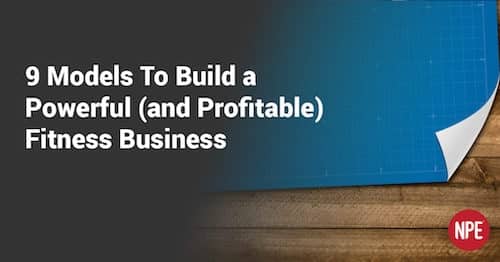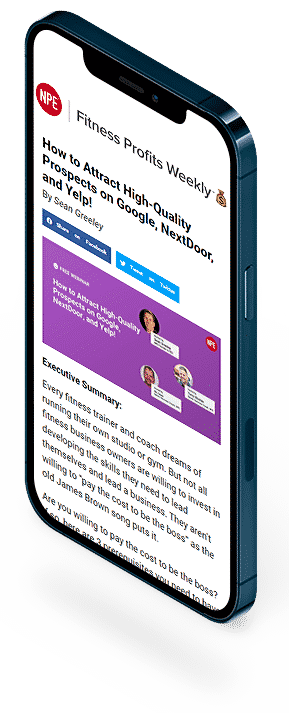9 Models To Build A Powerful (And Profitable) Fitness Business
By Sean Greeley

The fitness industry has evolved a LOT over the years. Today there are literally thousands of different ways that successful professionals and business owners are serving their clients and growing a business.
But what are the differences between them all?
Which business model is better (or worse) for achieving your goals faster and with more ease?
Should you be offering group training, private training, or semi-private training services?
What about online training?
Workshops or retreats?
And what about nutrition coaching, is this something you should be charging for or just including with your existing fitness training services?
Whether you’re just starting out, trying to improve your current business, or you want to discover how to add another line of business (and income) to your already successful operations… read on to discover how you can match the right business model to your personal and professional goals.
Over the last ten years, we’ve worked with over 21,000+ fitness businesses in 94 countries. We’ve seen a lot of success and a LOT of failure in the fitness industry.
While there are thousands of reasons why businesses fail, there are two factors always at the foundation of every successful business:
1. The business serves a profitable (and abundant) market.
2. The business model is clear, simple, and continually refined (over time) to grow and scale.
But before we dive into reviewing business models, it’s important we define some terms and review the difference between…
Modality vs. Model
Modality is the type of exercise programming, equipment, and protocols a fitness business uses to deliver services to clients.
A business model answers the fundamental question of how a business is structured to create revenue and earn a profit.
For example, while two fitness businesses may offer completely different programing and serve drastically different target markets (e.g., Crossfit gyms for 25-year-old fitness enthusiasts vs. yoga facilities for 40-year-old women), the business model is the same.
Both models offer group training services with a one-to-many instructor model, sold on a monthly subscription package.
But regardless of your preferred modality, here are some important keys to business success.
1. Choose an abundant (and profitable) target market to serve. Strong and successful businesses stick around for decades because they’ve focused on serving quality customers that truly value the services they receive. As a result, the business succeeds because its customers are stable and healthy. They don’t just purchase one time – they stick around for years.
2. Do your research and make data-driven decisions on choosing a location (for local businesses) with demographics that fit your target market. Smart business owners make decisions by the numbers, not just their gut. And for local service businesses, location matters. You’ve got to be in a location where it’s convenient for the target client to easily come see you several times a week. Unfortunately, the software tools that spit out demographic data (like the ones big companies use) aren’t cheap and are out of reach for most small business owners. But we’ve been fortunate to secure one of these tools, and we use it to review site selection with our clients as part of our NPE PROGRAM.
3. Match your model price point and service offerings to the clients you wish to serve. In the professional services industry, you’re either the cheapest or the best. There is no point in being just “average.” But that being said, you’ve got to match pricing to the market you want to reach and the type of services you’re offering. Get this right and you’ll be set up for success. Get it wrong and it’s difficult to make the economics of your business ever work right.
4. Differentiate your offerings in both the client experience and your market positioning to clearly communicate how your business is unique and different to those you wish to serve. A lot of people are uncomfortable working in competitive markets. But frankly, I look at competition as a good sign that there is plenty of demand in the marketplace, which is a good thing. The key is to get positioned so that your business stands out as unique and different to the segment of the market that you want to serve (which hopefully is the most profitable segment with the best customers that you’ll want to focus on building your business with!).
5. Optimize all functions of the business over time to continue serving the market and repositioning the company as needed when competitors show up in your space. Now that statement sounds like a lot because it is a lot. But if you put one foot in front of the other, you’ll get it done. There are a lot of functions in a business that take work to grow at every stage. Sales and marketing, services management, accounting and finance, administration, and more will ALL take work… as will growing the team that eventually manages key areas of your operations. There will also be competitors coming for you as you grow and lead the pack. You’ll need to continually reposition your company to stay ahead of the pack.
Alright, now that we’ve talked about the keys to success… let’s get into reviewing nine of the most successful business models used in the fitness industry.
Membership-based facilities have been around forever, way before the rise of personal training services.
There have been (and continue to be) thousands of spins on a membership model (large and small facilities, lots of services or minimal staff overheads with keycard entry) – some low cost, medium priced, and high-priced facilities.
Regardless, the model is essentially always the same… members pay a monthly (or annual) subscription fee to use the facility.
This model makes money when you have more members paying each month than it costs you to run (and maintain) the facility, plus additional profits made from other product and service offerings sold to members.
• Price Point: 10-100+/month subscription fees, plus initiation fee
• Pros: Great opportunity for scale in the right location, matched to the right market.
• Cons: Generally requires significant investment to build out and open, highly competitive business model with price wars, often very high churn rates each month with members.
Group training services have been around for a long time. Before fitness services like outdoor boot camps and Crossfit classes were the norm, martial arts, gymnastics, and many other types of sport programs have been delivered in this model.
In the fitness world, group exercise was first introduced as part of an added value offering to the membership model and became all the rage in the 1980s with aerobic classes.
Later this evolved into outdoor military inspired fitness boot camps, yoga, Kettlebell classes, Crossfit, and many more group training offerings.
Regardless of the modality, clients pay a monthly subscription service to enjoy instructor led and supervised instruction. There’s high leverage in the model depending on the coach-to-client ratio and monthly price point, which can vary anywhere from 10 to 25+ clients per instructor. Classes are usually delivered in a one-hour block of time.
• Price Point: 100-250+/month subscription fees
• Pros: Great leverage with one-to-many delivery of services, many models have low startup costs, and social component of community supports client retention.
• Cons: Low startup costs lead to lots of competition entering the market, often racing to the bottom with discounting practices in an attempt to steal market share.
Semi-private training is a hybrid model of group training and private training.
Generally clients are supported on a 3 or 4 clients to 1 instructor ratio.
In most cases, clients receive individual assessment and program design… yet are supported in their training through the small group format, adding a social “stick” component to the service delivery. Session length is typically 30, 45, or 60 minutes.
The demographic is generally middle-aged men and women who want individualized protocols to support their fitness goals, but don’t need elite training or one-to-one attention to get there.
• Price Point: 300-500+/month
• Pros: Highly profitable model when session times are maximized. Generally high retention rates from the “sweet spot” of mid-price point services, individualized prescription, great results, and social stick that comes from bonding with other clients training at the same time.
• Cons: The responsibility lies on the business owner to maximize the number of clients in each training time slot. If only one or two clients are training in the slot, then leverage and profitability is greatly reduced for that block of time.
Private training has grown tremendously around the world since the 1980s.
There are hundreds of national (and international) organizations that certify personal trainers to deliver private training services.
Sessions are delivered one-to-one, can last anywhere from 30 to 60 minutes (or even 90 minutes) depending on the training goals and clientele.
Generally speaking, the protocol is to set goals, assess the client, write a program, support training, and then reassess and adjust the programming as needed. And programing can include many different forms of fitness, sport, nutrition counseling, and other types of fulfillment offerings. But the model is always the same. One instructor shares their time with one client.
The demographic for this client base can range from 8 to 80, from newbie to professional athlete, and anything in between.
• Price Point: 350-1,000+/month
• Pros: There is ALWAYS a market for private training. As an independent professional, you can narrow your target market to work with the client base you love most, with the protocols you are passionate about sharing. Session length can be chosen to best serve the client. And startup costs are minimal depending on the location where you deliver services (shared space, outdoors, in home, etc.). Depending on price point, it doesn’t take a high volume of clients to earn professional income.
• Cons: The model is labor intensive without much leverage beyond raising price point, which has a limit depending upon the demographic you’re serving. Also small fluctuations in client base can have drastic affects on monthly income when clients drop off, are on holiday, or the like.
With the rise of the digital era, service providers have been able to scale their client base beyond their local market.
Services are generally delivered via email, web, and either phone or Skype. An online membership center with resources is often included as well. An online forum or group can also be used to build community among clients with common goals.
It can be more challenging to engage commitment to the program without being physically present to support a client in person, which is why the demographic for this service is generally the intermediate to advanced fitness client.
• Price Point: 150-300+/month
• Pros: Tremendous flexibility and freedom for the service provider and an unlimited market with the ability to serve anyone that can be reached online.
• Cons: The sales and marketing skill sets required to grow an online client base are much more comprehensive than simply growing a local client base. And the model can be more difficult to scale beyond the solo practitioner model.
Workshops can be delivered in a one hour, half day, or single to multi-day format.
They are generally marketed and fulfilled locally to participants that live within driving distance of the workshop location.
Often there is a very specific learning objective to be delivered. Education and training topics can range on a wide variety of subjects from nutrition, to skill-based practices like Olympic lifting, to recovery subjects like foam rolling, or any other subject matter that participants value investing time in learning more about.
• Price Point: 50-2,000+ one-time fee
• Pros: Great leverage and profitability and great addition to another business model for a local-based service business.
• Cons: Must be continually marketed and sold, which either requires travel to multiple locations with a local market that fits the target, or a varied course structure that allows the model to be resold on a regular basis to the same client base. There is no recurring revenue in the model.
Camps and retreats are centered around an “immersion learning” experience for the client.
They are generally delivered in destination locations where the participants are not only buying fitness training services (that often include multiple sessions per day, chef services, and lodging), but they are investing in experiences that create memories and build friendships within a small community to last a lifetime.
They are often sold to a well-defined target market that is highly engaged in the pursuit of their health and fitness goals and living a fitness lifestyle. Sometimes the event is positioned as earning a certification with the completion of the training, which also gives the participant a sense of achievement and recognition with the community.
• Price Point: 1,500-5,000+ one-time fee
• Pros: Great leverage and profitability, tremendous price elasticity in the model, events are often fun experiences for everyone in great destinations. This model is well suited for the independent practitioner that wants a truly “lifestyle” type business.
• Cons: Events must be marketed on an ongoing basis. There is no recurring revenue in the model.
Fixed-term challenges go in and out of fashion and popularity. This trend is currently on the rise again.
The model is used in selling services to support the client in the achievement of a short-term goal like body transformation, training for a big race, climbing a mountain, or something similar that challenges the participant to become a better version of themselves.
The model is probably best known for 12-week body transformation type programs, made popular by a number of people, but notably Bill Phillips and the Body For Life program in the late 90s.
• Price Point: 500-2,500+ one-time fee
• Pros: The model can be marketed and sold on a simple rolling launch strategy repeated throughout the calendar year. It offers great leverage and the defined term length in the program keeps clients highly engaged in the pursuit of their short-term goal.
• Cons: Requires a big enough market to support the continual sale of the program due to the short-term nature and lack of recurring revenue with clients.
The nutritional supplement industry is a global industry that generates billions in revenue each year.
Fitness clients are generally already purchasing products, but looking for expert guidance as to which products they should be taking and how to integrate them into their nutrition plan and daily habits.
There are little to no startup costs for independent distributors, usually great margins, and the model has virtually no limitations on the number of customers that can be served each month.
• Price Point: 50-250+/month
• Pros: No startup costs, tremendous leverage, great margins.
• Cons: Almost none, other than the search to represent a product line and brand that aligns with your beliefs and values.
Educational information products have taken many forms over the years.
From books, tapes, DVDs, e-books, and more… the media may change, but the model is essentially the same.
Generally low-to-mid price point education is sold to a specific audience to share and introduce a model for fitness success.
• Price Point: 10-150+ one-time fee
• Pros: Great branding and positioning for a professional, tremendous opportunity for scale with online marketing strategies.
• Cons: One-time product sale supports customer acquisition, but does not create recurring revenue alone. Tremendous amount of skill and time is required to learn and apply all of the digital marketing strategies needed for success.
Summary
There are thousands of reasons why businesses fail, but at the foundation of every successful business are two keys to success:
1) The business serves a profitable (and abundant) market.
2) The business model is clear, simple, and continually refined (over time) to grow and scale.
I’ve shared nine of the most popular models (plus one bonus model) in this article with you, but there thousands of different companies all profitably growing with the same model that vary in the target market they serve, the training modality they deliver, and the positioning of their company.
Rome wasn’t built in a day, and businesses (and their models) are always being continually refined and improved over time.
But if you’re willing to stay committed… and practice patience and persistence in the journey of business ownership and entrepreneurship… you will make it to the top. It just takes time and hard work to get it right!
For further reading, be sure to download our 9 Fitness Business Model Blueprints For Success guide that’s jam-packed with step-by-step plans to grow your business faster and increase your income in the year ahead (and beyond).



















